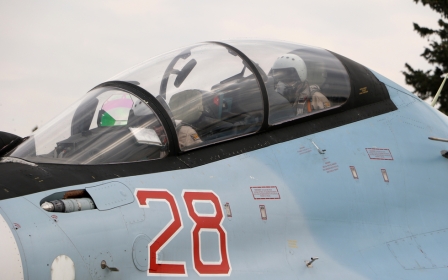Syria army 'just kilometres' from IS-held Palmyra

Battles raged around Palmyra on Monday, as Syrian soldiers backed by Russian warplanes sought to recapture the ancient city in what would be a major symbolic victory over the Islamic State group.
Since early March, troops and allied militia backed by Russian air power have been pushing an advance around the UNESCO World Heritage Site known as the "Pearl of the Desert".
They are now just four kilometres (2.5 miles) from the gates of the city that fell to the militants in May last year, sending shockwaves around the world.
According to the Syrian Observatory for Human Rights monitor, the advance has been "slow" despite some 800 air strikes by Russia and the Syrian government this month alone.
Last week, the army recaptured a strategic hill at the southwestern entrance of Palmyra, four kilometres from the city.
IS has fiercely resisted the advance, killing at least 26 pro-government fighters on Monday, the Observatory said.
Aamaq, an IS-linked website, claimed that 30 troops were killed in an attack by an IS suicide bomber.
"Meanwhile, warplanes believed to be Russian struck parts of Palmyra city and its surroundings in the east of Homs province, as well as Al-Qaryatain in the southeast," the Observatory said.
"The battle for Palmyra is decisive for the regime, as it paves the way for the recapture of the desert area all the way up to the eastern border with Iraq," Observatory director Rami Abdel Rahman told AFP.
"IS would automatically lose the desert stretching from Palmyra to the Iraqi border - in other words, 30,000 square kilometres (12,000 square miles)," he added.
That would cut IS's area of control from some 40 percent of Syrian territory to 30 percent, the Observatory said, adding that militants could then be pushed across the border into Iraq.
Symbolic value
IS, however, has proved resilient and on Monday reports emerged that the group had made gains in the southeastern Daraa province and raised its black flag over several villages for the first time – making it the first successful IS advance this far south.
Thomas Pierret, a Syrian expert at the University of Edinburgh, also said he doubted that the army would be able to advance much further beyond Palmyra.
"Let's not forget that whatever its advances in Palmyra, the regime is still fighting very difficult battles against IS in the desert west of Palmyra, in the eastern parts of the provinces of Homs and Hama," he told AFP.
But recapturing Palmyra would still be an important victory for the Assad government that is locked into talks with most Syrian opposition groups in Geneva but is still allowed to battle IS and al-Qaeda affiliate the Nusra Front under the ceasefire terms that preceded the talks.
"Symbolically it would be huge, since it would enable the regime to portray itself as the protector of Palmyra's antique ruins, even if this comes at the price of turning the modern, inhabited part of the city into rubble," Pierret said.
Should the Syrian army retake Palmyra, that would also "help pro- (President Bashar al-) Assad lobbying in the West, which in the medium/long-term could be a game changer," he said.
Even though the capture of Palmyra might prove beneficial to Assad’s political future in the long run, UN's Syria envoy on Monday pressured the government to make concrete proposals on political transition, as Damascus again ruled out any negotiations about the fate of President Bashar al-Assad.
The apparent impasse on the crucial issue of forming a transitional Syrian government came as peace talks in Geneva entered a second week, with United Nations mediator Staffan de Mistura underscoring the need to make gains before negotiations pause on Thursday.
Since IS captured Palmyra, the city has become practically deserted after most civilians took flight.
Images recently distributed by the Observatory purported to show residential areas of the city in ruins after months of air strikes.
"The regime has adopted a scorched earth policy, and is trying to advance on several sides of the city," said the Palmyra News Network, which is run by local activists.
Some families that had remained were now fleeing towards the Jordan border, fearing for their lives, the group said.
Global concern for Palmyra's magnificent ancient ruins spiked in September 2015, when satellite images confirmed that IS had demolished the famed Temple of Bel as part of its campaign to destroy pre-Islamic monuments it considers idolatrous.
The militants have waged a sustained campaign of destruction against heritage sites in areas it controls in Syria and Iraq, and in mid-August last year beheaded the city's 82-year-old former antiquities chief.
Middle East Eye propose une couverture et une analyse indépendantes et incomparables du Moyen-Orient, de l’Afrique du Nord et d’autres régions du monde. Pour en savoir plus sur la reprise de ce contenu et les frais qui s’appliquent, veuillez remplir ce formulaire [en anglais]. Pour en savoir plus sur MEE, cliquez ici [en anglais].





